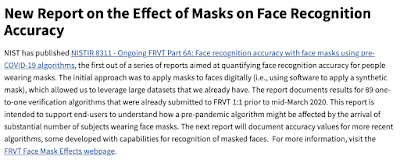With many jurisdictions imposing mandatory masking for their citizenry, it was just a matter of time until someone figured out that there would be an unintended consequence to this policy. Apparently, the United States Department of Homeland Security, the government arm in charge of protecting the homeland, has realized that there is a downside to masking.
In many parts of the globe, facial recognition has become one of law enforcement's key crime fighting tools. The combined use of CCTV and artificial intelligence technology has allowed governments around the world to track individuals and, since the early days of the War on Terror been adopted as a means of tracking and ultimately apprehend and neutralize potential terrorists. In the case of the United States, Ban Facial Recognition has "tracked the trackers" and created this map which shows where facial recognition surveillance is occurring in the United States:
Research has shown that facial recognition technology already has issues with non-white, non-male identification as shown in this quote from a 2019 study conducted by the National Institute of Standards and Technology:
"Using the higher quality Application photos, false positive rates are highest in West and East African and East Asian people, and lowest in Eastern European individuals. This effect is generally large, with a factor of 100 more false positives between countries. However, with a number of algorithms developed in China this effect is reversed, with low false positive rates on East Asian faces. With domestic law enforcement images, the highest false positives are in American Indians, with elevated rates in African American and Asian populations; the relative ordering depends on sex and varies with algorithm.
We found false positives to be higher in women than men, and this is consistent across algorithms and datasets. This effect is smaller than that due to race.
We found elevated false positives in the elderly and in children; the effects were larger in the oldest and youngest, and smallest in middle-aged adults."
While facial recognition still has issues with both false positive and false negative identifications, the use of face masks during the COVID-19 pandemic has led to an even greater problem according to the Department of Homeland Security. Here is a May 2020 Intelligence Note entitled "Violent Adversaries Likely to Use Protective Masks to Evade Face Recognition Systems" from the Counterterrorism Mission Center:
Here is a key quote:
"We assess violent extremists and other criminals who have historically maintained an interest in avoiding face recognition are likely to opportunistically seize upon public safety measures recommending the wearing of face masks to hinder the effectiveness of face recognition systems in public spaces by security partners...While we have no specific information that violent extremists or other criminals in the United States are using protective face coverings to conduct attacks. some of these entities have previously expressed interest in avoiding face recognition and promulgated simple instructions to conceal one's identity, both prior to and during the current COVID-19 pandemic."
As a bit of background, face masks/coverings were used by demonstrators in Hong Kong to defeat the government's CCTV tracking and identification systems.
The National Institute of Standards and Technology (NIST) has announced that it will be testing the effects of masks on facial recognition accuracy as shown here:
...and here:
NIST used software to apply masks to 6.2 million facial images that are in its database as part of its tests; this allowed NIST to use a variety of shapes, sizes and colours of masks. The test using border crossing images without masks failed to authenticate 0.3 percentage of persons. This false rejection rose to about 5 percent with the highest coverage masks tested. They also found the following:
1.) The shape of the mask affects performance of the facial recognition algorithm with wider masks given false negative rates two times higher than rounder masks (i.e N95 masks).
2.) Darker coloured masks result in higher errors than lighter coloured masks.
It is important to note that NIST did not test images where the subjects were wearing eye glasses or other eye protection and it only tested masks that were of a uniform colour, unlike the wide diversity of masks that many people are wearing during the COVID-19 pandemic. It also did not test photographs that had subjects wearing real masks since it claimed that these masks may not fit as well as the "software masks" added to photographs by NIST. This clearly suggests that the real world error rate may be significantly higher than NIST is currently projecting.
As is typical of government mandated programs, there is often an unforeseen negative consequence. In the era of mandatory COVID-19 masking, governments around the world will quickly ascertain that they are far less able to identify their citizens using facial recognition than in the world before the SARS-CoV-2 virus began its global journey.











This is precisely one of the reasons for mask mandates. They knew they were going to promote looting and chaos and the mask mandates were created to provide cover for rioters.
ReplyDelete